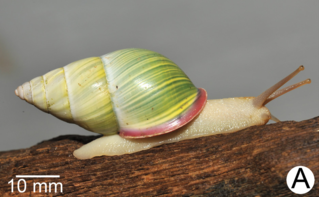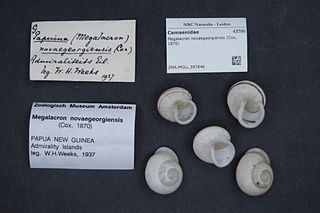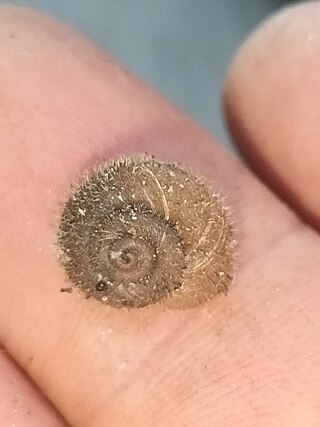
Amphidromus is a genus of tropical air-breathing land snails, terrestrial pulmonate gastropod mollusks in the family Camaenidae. The shells of Amphidromus are relatively large, from 25 mm (0.98 in) to 75 mm (3.0 in) in maximum dimension, and particularly colorful. During the 18th century, they were among the first Indonesian land snail shells brought to Europe by travelers and explorers. Since then, the genus has been extensively studied: several comprehensive monographs and catalogs were authored by naturalists and zoologists during the time period from the early 19th to the mid 20th centuries. Modern studies have focused on better understanding the evolutionary relationships within the group, as well as solving taxonomic problems.

Camaenidae is a family of air-breathing land snails, terrestrial pulmonate gastropod mollusks in the superfamily Helicoidea, the typical snails and their allies. This is one of the most diverse families in the clade Stylommatophora.

Amphidromus givenchyi is a species of air-breathing land snail, a terrestrial pulmonate gastropod mollusk in the family Camaenidae.

Amphidromus flavus is a species of air-breathing land snail, a terrestrial pulmonate gastropod mollusk in the family Camaenidae.
Chloritis is a genus of air-breathing land snails, terrestrial pulmonate gastropod mollusks in the subfamily Hadrinae of the family Camaenidae.
Chloritis vanbruggeni is a species of air-breathing land snail, a terrestrial pulmonate gastropod mollusk in the family Camaenidae.
Chloritis balatensis is a species of air-breathing land snail, a terrestrial pulmonate gastropod mollusk in the family Camaenidae.
Chloritis biomphala is a species of land snail, a terrestrial pulmonate gastropod mollusk in the family Camaenidae.

Chloritis macrostoma is a species of air-breathing land snail, a terrestrial pulmonate gastropod mollusk in the family Camaenidae.
Chloritis minahassae is a species of air-breathing land snail, a terrestrial pulmonate gastropod mollusk in the family Camaenidae.
Chloritis talabensis is a species of air-breathing land snail, a terrestrial pulmonate gastropod mollusk in the family Camaenidae.
Chloritis togianensis is a species of air-breathing land snail, a terrestrial pulmonate gastropod mollusk in the family Camaenidae.
Chloritis planorbina is a species of air-breathing land snail, a terrestrial pulmonate gastropod mollusk in the family Camaenidae.

Pommerhelix monacha is a species of air-breathing land snail, a terrestrial pulmonate gastropod mollusc in the family Camaenidae.

Amphidromus roseolabiatus is a species of air-breathing land snail, a terrestrial pulmonate gastropod mollusk in the family Camaenidae.

Trachia is a genus of air-breathing land snails, terrestrial pulmonate gastropod mollusks in the family Camaenidae.

Megalacron is a genus of air-breathing land snails, terrestrial pulmonate gastropod mollusks in the subfamily Hadrinae of the family Camaenidae.

Bouchetcamaena is a genus of air-breathing land snails, terrestrial pulmonate gastropod mollusks in the family Camaenidae.

Tolgachloritis is a genus of air-breathing land snails, terrestrial pulmonate gastropod molluscs in the family Camaenidae. The genus was first described in 1933 by Tom Iredale, and the type species is Chloritis jacksoni Hedley, 1912. Iredale described them as "hairy".









